pedroncelli
-
Vintage Notes
March 30, 2021 16:22
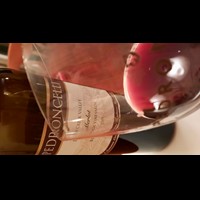
This is the first of a monthly blog post on wines from our cellar here at the winery. Ed, Colin and I have been taking apart stacks of wines in our warehouse and inventorying them. We of course need to taste them to make sure they are doing fine, drink now or forget about it.
It began last month with Open That Bottle Night but as we delved into the cases of wine stacked in and around the warehouse we realized doing some tasting notes on these gems would be a good thing to have here on Vino in my Dino.
2009 Merlot
Cork Finish
This was a nice surprise. The very mellow wine with touches of red brick around the edges of the glass. Softened by age this Merlot still has the stuffing to age another year or two. The beauty of this gem is it is ready to drink now should you have some in your cellar-a few more years will be okay as well.
2002 Alexander Valley Cabernet Sauvignon
Cork Finish
From the Morris Fay vineyard this is a wine that has aged quite well. Notes of tobacco, leather and a nice fruit core of cherry on the aromatics as well as flavor. A long finish is framed by softening, but not too soft, tannins signaling this wine will age well for a few more years.
2001 Block 007 Cabernet Sauvignon
This is the first year we made a small lot wine from this block. And I am here to tell you this has aged beautifully. Notes of dried herbs linger on the nose along with touches of plum and black pepper spice.
2016 Signature Selection Chardonnay
Screw Cap
Not much color change-a deepening gold perhaps from the pale yellow of first release. Still lively with mellowed aromatics of melon and apple. Acidity is still bright, the flavors are rich and the finish is heightened by the perfect balance of fruit and acidity.
-
Making Connections: Manuel Diaz
March 30, 2021 16:15
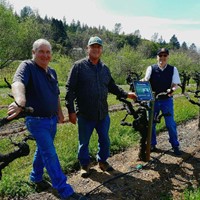
The other day my sister Lisa shared an idea she had to highlight our staff by telling their background story. She is a fan of the PBS series Finding Your Roots so she envisioned these stories as connecting our co-workers between where they came from and where they are now at Pedroncelli.
Serendipitously I already had something in the works about our Vineyard Foreman José 'Manuel' Diaz, who had been featured as an Employee of the Month by the Sonoma County Winegrowers in the local paper. Manuel was nominated by Jim and Lance for the Vineyard Employee Recognition Award which is awarded for individual achievement and exceptional performance. He has worked 37 years here and continues to love what he does. As the article said: "Sustaining a family farm requires love, commitment and hard work. We are proud to recognize the people who help us grow the world's highest quality winegrapes."
The photo above shows Jim Pedroncelli presenting Manuel with a framed copy of the honor along with Vineyard Manager Lance Blakeley. Here is Manuel's story.
Manuel was born in the village of Tumbiscatío, in Michoacán. His grandfather had moved there from Spain and his father, Feliciano, grew up there as well. The path to the U.S. began with the Bracero program and Feliciano spent a few years in this program and then made a permanent move. Manuel, at the age of 18, followed his father in 1978. His first day in Dry Creek Valley was March 23rd—and he went to work for Raymond Burr, the late actor, who later on planted vineyard.
A short time later his father came to work for John Pedroncelli and Manuel followed in the early 1980s. He first worked on the bottling line and then in the cellar for about 10 years. He then made the move out into the vineyard when his father was no longer able to work there and later on became our Vineyard Foreman.
Trials and Triumphs:
By working in the cellar first he realized how important it was to have quality vineyards. Learning how to get the best grapes through farming practices was key in the connection. He says it is eye opening what goes into why you do certain things in the vineyard (fertilize, pruning, crop cover) in order to make great wine.
He became a home winemaker for a vintage or two and made late harvest Sauvignon Blanc. He realized it was easier to make red wine than white wine as it is more delicate an operation and decided to give up his winemaking dream.
His philosophy is very similar to John Pedroncelli's when it comes to how we work together. He considers everyone as the whole team-while each contributes to the work it is the crew together that makes it all flow from the vineyard to the cellar. Another challenge he has met is putting together the harvest time crew for picking grapes. A bigger crew brings in many personalities-sometimes as many as 25. This is the reason he was nominated for the award-he is able to organize, talk to and encourage the different people coming together for the short time at harvest so things will go smoothly.
Another challenge he has met is putting together the harvest time crew for picking grapes. A bigger crew brings in many personalities-sometimes as many as 25. This is the reason he was nominated for the award-he is able to organize, talk to and encourage the different people coming together for the short time at harvest so things will go smoothly.
I have seen him at times in the evening driving along the vineyard avenues-he says that is when he reflects on the day, looking for what needs to be accomplished, moving toward the next project.
Other milestones include producing a video about Adelante, a program aimed at educating and encouraging Hispanic youth, meeting and marrying his wife Norma in 1989, and the birth of his five children. Quite a few connections from a small village in Mexico to Pedroncelli in the span of 37 years.
I will continue the stories from more of our staff and beyond all the while keeping in mind your connection to us and the journeys we have all made. -
Postcards from Home: Bottling Up
March 30, 2021 16:10
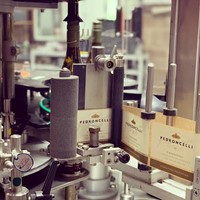
March brings us rain, spring, setting our clocks forward and, at Pedroncelli, the cellar crew is busy getting wines ready for their final stop before coming to you—the bottling line. We usually begin bottling the white wines from the previous harvest in February followed by the red wines from the previous harvest as they finish aging—some see 12 months while others a little longer. The bottling schedule lasts for about six months—just in time to get ready for harvest and all that brings.
From winemaker Montse Reece is a snapshot of preparation to bottle. “One week before bottling we rack the wine off (with either bentonite for white wines and gelatin for reds) and filter the wine. All wines, except the Port, get cross-flow filtered. After filtration I adjust the sulfur levels for bottling and check the specific gravity that I use to check the fill levels during bottling. We order nitrogen to purge the empty glass bottles before they get filled with wine.
Bottling day starts with the sterilization of the line (pipes/filler bowl/filters). During bottling we check fill levels and adjust, if necessary, the oxygen levels in nitrogen purged bottles and in wine to be sure we are under 1 ppm (part per million) O2, vacuum pressure on the corks, torque pressure in the screw caps and filters pressure. Then the wine is packaged and stored until release.”In Line
Montse mentions nitrogen to purge the bottles and here they are in line to begin the filling process.
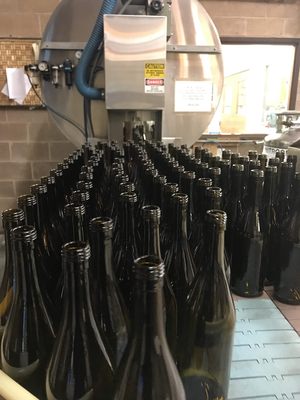
The Line Up
Once filled and sealed with a screw cap or cork, they make their way to the labeling section.
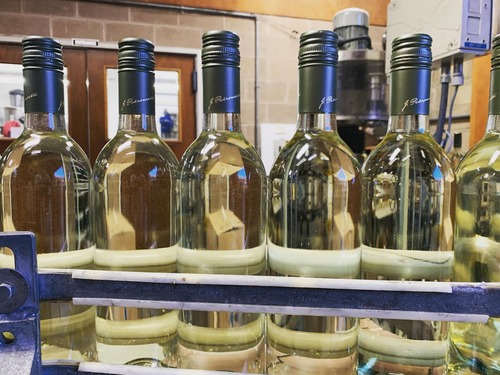
Labeling Up
In the early days there was the label and then there was glue, slicked onto the label as it was placed on the bottle. If these were on white wines they’d eventually slide off after being on ice for an hour or two. Today self-adhesive labels are the way to go and do their part to stick when submerged in that tub of ice at your next picnic.

The Finished Product
Our family of wines waiting for you to try one—we make many choices so there is something for every palate and taste.
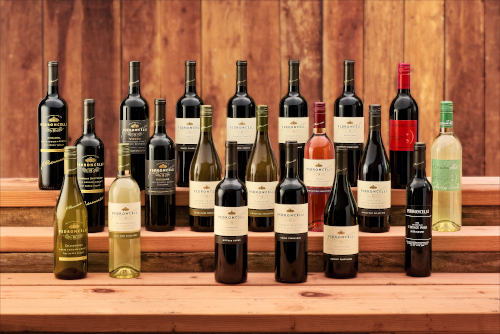
-
PurpleRedOrangeYellow
March 30, 2021 16:06
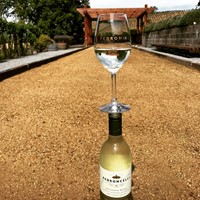
Tuesday, March 16, marked the one year anniversary of the pandemic for us. We closed our Tasting Room, battened down the hatches, followed the news very closely and here we are a year later. We started off not knowing how all of this would go, how many weeks we'd have to wait. And I think many of us thought it would all be over soon and never considered a full year of opening, closing and opening back up again in our tasting room as well as restaurants, hair salons and hotels and beyond. Who could have predicted all of this?
In a recent zoom session one of my friends, who lives in California, rattled off the colors of our COVID tiers in a sing-song voice and it stuck with me, hence the title. The colors Purple, Red, Orange, and Yellow are assigned to the tiers by the state of California with differing levels of COVID statistics. Purple is the most impacted and of course yellow signals better days ahead. The tiers determine how we operate as a tasting room and how restaurants and retail can operate as well-masks and physical distancing are still part of this time. I hear a Green tier is being develped as the final color for giving us all a go ahead-I for one am looking forward to that.
On Sunday as we spring forward the county will go from the Purple to the Red tier. At this time there is no difference in how we operate-still outside tasting by reservation. Moving into the Orange tier means we'll have inside tasting again. Our state and county officials continue to work toward reopening the schools and other businesses so hard hit by the shutdown and the colors will shift slowly from Red, to Orange then Yellow.
All along the cellar and vineyard staff kept going because agricultural work is considered essential. They worked together to keep safe and are now on their first and second vaccinations thanks to county trade groups like the Sonoma County Winegrape Commission being at the forefront of providing the vaccination information. In fact I just heard the town of Geyserville has the most vaccinations per person than anywhere else in our county.
COVID operations continue and include maintaining and keeping areas of use clean, very clean. Sanitizer now complements the soap dispenser and there is a bottle in every possible spot to keep on sanitizing. Gary has become an expert with these guidelines and the tasting room crew continue to welcome guests and keep them comfortable as they take in the refreshing outdoors and taste through a flight of wine.
What did we learn from this time?
Did you know that the common cold and flu has been cut back by some 85% because of the masks, sanitizing and social distancing? That speaks volumes.
People like to order Pedroncelli wine! We have seen surges at different times over the year but overall we are seeing a large number of orders even today via online and phone-this avenue of ordering has become the norm.
You really want to come back to visit. Our virtual events were popular but don’t replace the ‘real’ thing of being in each other’s presence. There is nothing like sitting down to an experience here at the winery and tasting wine at the source.
I learned I could visit with different accounts in my markets through Zoom and it was just as fun talking to folks and tasting through the wines with me in Healdsburg and them in their stores or restaurants. I learned how things are going in each of their cities or towns across the country.
What did you learn? My inbox is open, as always, to hear from you julie@pedroncelli.com By this time next year I'll look forward to seeing many of you in person.
-
Women's History Month: We Are Family
March 8, 2021 14:22

A while ago I took part in a seminar entitled “Growing up Among the Vines” and one of the stories I told was about my sisters and I building vine houses under head pruned Chenin Blanc vines. I remember it was cool inside the canopy of long canes and large leaves in the days just before harvest. We had our own vine village. This and many other memories are with me as I reflect on four generations of family ownership.
March is Women’s History Month designated each year by proclamation from the President. Women’s History Month is chosen each year to celebrate the achievements and contributions made to our great nation. We have been quietly working in our corner of Dry Creek Valley with women in every generation contributing to the success of the winery.
As a third generation member and the oldest of four Pedroncelli daughters my experience is filled with many memories of growing up side by side with the family business. My grandmother Julia, matriarch of the first generation, kept the books, entertained many visitors with her cooking and hospitality, and helped our family business blossom. Daughters Margaret and Marianne, sisters to John and Jim, took part in the early years out in the vineyard and farm. Later Margaret, along with husband Al Pedroni, became a longtime grower of Zinfandel, an extension now of our estate vineyards farmed by daughter Carol.
Grandparents, aunts, uncles, dad and cousin celebrating Sunday dinner.
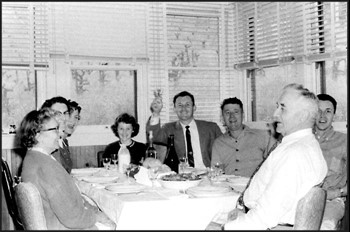
Also from the second generation, my mom Phyllis took over bookkeeping when my parents moved to the family home at the winery in the mid1960’s. She weighed in grape trucks, managed the office and later went on marketing trips with my dad doing all she could to help the winery go forward. Christine, uncle John’s wife, worked side by side to further the business as well. Her interests took her into the world of politics with many community and civic activities including the first woman president of the Santa Rosa Junior College Board of Trustees, appointed by Sonoma County on the Dry Creek Zoning Committee, part of the committee to build the Geyserville Educational Park, Chairman of the Santa Rosa Memorial Hospital Board of Trustees and many other accomplishments. While no longer with us she blazed her own trails.
Christine, Jim and Phyllis partners from the second generation.
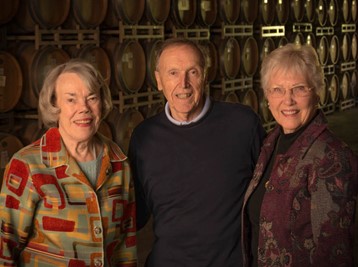
In the third generation, my sisters Cathy, Lisa and Joanna all have made great contributions throughout the years as well as cousin Maureen, who is a board member of JPW Inc, is also know for her singular talent as chef. Fourth generation member Denise is our graphics designer. Our daughter Adrienne is a winemaker in her own right down in the Central Coast of California. To this day we work side by side here at the winery each of us using our own talents like the previous generations to shepherd our interests forward. I am honored to follow in the footsteps of such great examples and strive to do more and be more in the coming years. A toast with Rosé in my glass to generations of women in our family-93 years and counting!
The Pedroncelli sisters Joanna, Julie Lisa and Cathy.
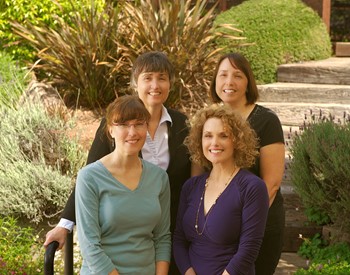
-
#PairItWithPed: Soup's On!
March 2, 2021 15:29
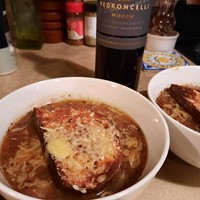
Soup is always welcome in our house-from Minestrone to French Onion Soup and everything in between. In my house we are a year round soup family. Of course there are changes in types and vegetables as the seasons and temperature outside comes into play. Pairing wines with soup is as easy as pairing with any other dish. I have so many to choose from among the recipes posted on our site-but these are some of my favorites.
The other day my dad had a hankering for Split Pea Soup. Ed is a fan of this soup as well so away I went gathering the ingredients. It is one of those hearty winter-time choices with the wonderful aromas of the herbs and the ham filling the air. Nice and thick with tender chunks of carrot and smoky ham this soup calls for our Rosé or on of our red blends-friends.red or Sonoma Classico. And sharing the pot of soup with my parents made me happy.
Another favorite of many is Classic French Onion Soup. I often think this takes sooo much time but it really is just a matter of cooking down the onions and then letting the herbs and beef broth do their magic. Toasting slices from a local bakery’s French bread and then piling some Gruyere on top and melting it all over the soup gives such depth of flavor and richness. Pair with our Wisdom Cabernet or try our Chardonnay if you want something lighter.
Minestrone is much loved and a hearty soup all on its own-just add bread. And you don’t have to be Italian-American to enjoy it. I had read about using parmesan rind in a soup as it cooks-it adds a depth of parm-deliciousness. If you have some pesto handy that will perk up the flavors in this soup even more. Paired with Sangiovese or Sonoma Classico you are set.
With a swirl of pistou (or pesto) you have a tasty vegetable-based soup. Soup Au Pistou is a great combination of veggies and herbs with the piquant flavors of pistou. Paired with our Sauvignon Blanc or Chardonnay you have a winning combination.
I have made this one for a very long time-I found it in a newspaper so the clipping is well used and now I can make it from memory. I have brought my Turkey Sausage Vegetable Soup to church soup night and found many fans of the flavor-especially our friend Barb. I’d make this once a week for 9 months of the year if I could-and you can never have too much chard! Pair up with our Mother Clone Zinfandel for a treat.
-
Cellar Treasures
March 1, 2021 15:51
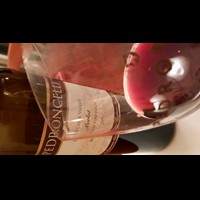
This year Open That Bottle Night, founded by Dorothy Gaiter and John Brecher, is February 27, always the last Saturday of the month. In celebration I’ll be opening up a bottle or two (for sure the 2009 Mother Clone Zinfandel) along with a couple of other surprises-from a trip Ed and I took 30 years ago.
As I wrote about in my last note from home the wine to open on this special night doesn’t have to be aged-it could be a recent vintage or one with a story behind it. Either way looking through your stash is a great way to keep up on what you may have tucked away for a special occasion and now can enjoy along with thousands of other folks around the world.
Over the years here at my desk I have received many emails asking if one of our wines is still drinkable. These cellar treasures have come from intentional or accidental cellars: the back of the closet, given as a gift or found in their parents’ or grandparent’s cellar. The first question I get: Is it okay to drink this wine?
If the writer didn’t include a photo with the message I ask some follow up questions before answering: what does the bottle look like? Is the fill level low or high; check for leaks-if the capsule/cork has evidence of leakage it might have spoiled. Do they know how the wine was stored overall? An even cool cellar temperature of 55-60 degrees tends to be the best for long term cellaring. And of course if the wine is a gift this would be difficult to determine.
On the other hand I have received notes from many people who have opened that bottle and want to share their findings. The oldest vintage was from Mike K who opened a bottle of our 1968 Cabernet a couple of years ago. Overall the experience, as told by the messages, was good as our wines had held. Our longevity, having vintage dated our wines from 1965, allows quite a few of these stories to make their way to me.
So what is the difference between a current release wine and an aged one? You might notice the first difference is the color between the two. A young wine is almost jewel like in appearance and the aged one starts to get reddish brown around the edges. The aromas between the two include ripe berry and toasted oak in one and dried fruit with cedar and tobacco notes. Flavor is deeper in the new wine and more delicate in the aged version. It sometimes boils down to preference in flavor and I frankly prefer a younger wine but tasting a wine that is 30 or 40 years old is both an education and experience for the palate.
Here are some of the notes sent to me over the years and a couple of blog posts and a video from Gabe Sasso covering even more:
Your cab (1982 Reserve) was terrific, fresh, no brown rim around the glass and tasty. In a blind tasting no one would have guessed it was 38 years old. Jud R.
This evening we enjoyed pan-seared lamb stew meat, oven-roasted potatoes and carrots, and Pedroncelli Zinfandel Mother Clone 2011. The wine was quintessential Dry Creek Valley claret. Flawless. Sublime. Heavenly. Bob B.
Vintage Report: 1968 Cabernet Sauvignon
Aging Wine: The Good, The Ugly, The Bad
Gabe Sasso on 3 Vintages of Mother Clone Zin
These messages from the bottle tell some of us we need to dig deep and find those treasures to enjoy them before it is too late. And keep in mind, when the 2020 wines are released it would be a good thing to buy them from this memorable pandemic vintage. When the time comes you’ll open, share and remember your vintage story.Our trip to Paso Robles in 1990 was filled with visits to the wineries along Hwy 46-and Estrella River was one of them. Their Muscat Canelli held very nicely with honeyed notes and caramel popcorn flavors. It was the first road trip we took after we were married.
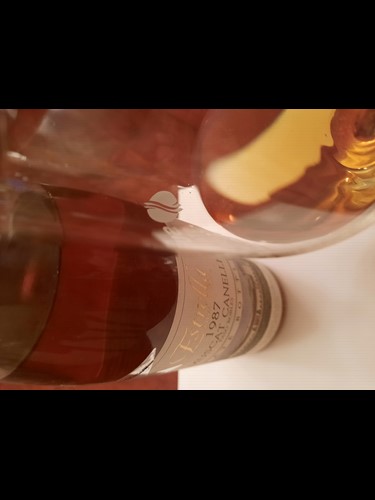
-
Note from Home: Celebrate Open That Bottle Night
February 25, 2021 10:56
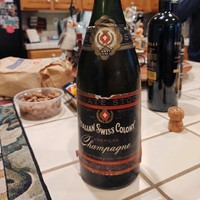
There are milestones in our lives that warrant opening a bottle of wine. Many are celebrations and others are mid-week dinners waiting to have them enhanced by a special bottle of wine. The wine could be a long-aged friend or a new addition-maybe one picked up on your last visit to wine country or recommended by your favorite retail store. This weekend my parents are celebrating their 62nd anniversary! We’ll be enjoying the occasion over the weekend and opening a bottle or two. While we don’t have a 1959 vintage of anything there will be some others that bring back memories.
They saved a bottle of sparkling wine from their wedding day and over the years it moved with them from house to house, refrigerator to refrigerator. I am fairly certain the wine is no longer drinkable but the bottle has always held the memory of their special day.
Sometimes we wait too long and find a bottle that should have been enjoyed earlier from our stash. Much like my mom and dad’s bottle of bubbly. In order to change that there is an annual celebration ‘just because’. Open That Bottle Night (OBTN) is the last Saturday of February so this is a heads up in order to prepare. This tradition was started by Dorothy (Dottie) J. Gaiter and John Brecher who conceived and wrote The Wall Street Journal's wine column, "Tastings," from 1998 to 2010. Dorothy and John have been tasting and studying wine since 1973. Dottie has had a distinguished career in journalism as a reporter, editor, columnist and editorial writer at The Miami Herald, The New York Times, and at The Journal. John was Page One Editor of The Journal, City Editor of The Miami Herald and a senior editor at Bloomberg News. They are well-known from their books and many television appearances, and as the creators of the annual, international "OTBN" celebration of wine and friendship. The first bottle they shared was André Cold Duck.
According to Dottie, “John and I invented OTBN to provide an impetus for people to enjoy a wine they had been keeping for a special occasion that never arrived. Weddings, births, anniversaries, all manner of special milestones had come but those corks remained intact. We knew this happened because readers told us about bottles like that and we have many ourselves.”
“While we urge people to open them as often as possible, and we try to do that because no one is promised tomorrow, there are still some bottles that we just haven’t brought ourselves to open. Some are rather young, but special to us, still. The point is to open these gems with someone you care about and celebrate the memories that are in that bottle. Make them the occasion. Recognizing that sometimes it takes a village to do something difficult, we set a date, the last Saturday in February, for this global celebration of friendship, love and wine.”
My Note from Home in May, What’s Your Vintage Story, reminds us to consider the vintage on the bottle. As you take a look at the wines you have saved for a rainy (snowy or sunny) day, take a moment to recollect what happened in that particular year when you Open That Bottle Night next week. And like Dottie & John asked me, I would love to hear of your plans or what you thought of the wine you opened! When I sought permission to share the OTBN information and recent articles Dottie said, “Open That Bottle Night is always special but this year's, we hope, will be celebrated with deeper feelings of gratitude, love, and reflection.” I have my eye on a 2009 Mother Clone Zinfandel-how about you? -
The Importance of Aging
February 16, 2021 14:37
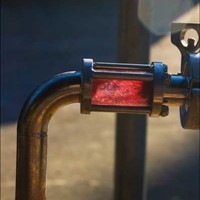
In this post we take a closer look at the barrel room and what goes on during the year. If you have visited our tasting room you would see we have a window looking into the process-at different times of the year the view is of the cellar crew taking down each and every barrel about every three months-whether it is to empty them out of the previous vintage, top them off or fill them up with the latest harvest.
Barrels at Rest
Quietly aging away, these barrels are at rest. Incremental changes happen over the cellar year. There is quite a bit of work that goes into ensuring each barrel is checked several times throughout the aging process. We have up to 2000 barrels at any given time during the year either being filled or being emptied of their contents.
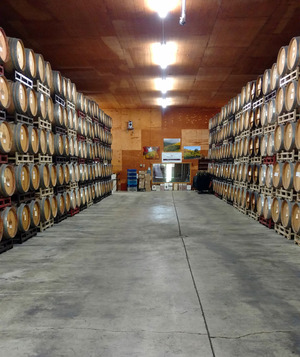
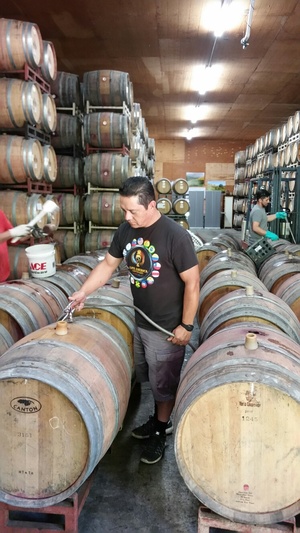 Barrel Vocabulary
Barrel VocabularyThere are some fancy words in the world of wine, some of them borrowed from the French winemaking tradition: Bâtonnage, Ullage, Sur Lie. In this photo of cellarmaster Polo Cano and his crew you’ll see them in action as I describe some of these terms:
We use the word ullage to describe the loss of wine due to evaporation while the wine ages in barrel or bottle. In a bottle you can see the fill line (or ullage) and if there has been too much loss over time then the wine may have had too much oxygen and, in some cases the wine might be bad. The same happens in the barrel but to a larger degree-larger container more loss, meaning a gallon or three over the year. This is often referred to as the angel’s share-the portion evaporating away while slowly oxygenating the wine. This concentration of barrel contents brings a slow softening of the raw red wine. In the case of barrels they are topped up 3 times in the course of their year in barrel and this maintains quality with no spoilage.
Bâtonnage is the stirring of the barrel. Each time the barrels are taken down for topping the barrels are stirred with a long baton, incorporating the lees and enriching the wine. Sur Lie means the wine in the barrel is aged with the ‘lees’ or dregs, if you will. It is made up of the dead yeast cells and perhaps bits of skin and seeds-small bits. When a wine is aged ‘sur lie’ it is all the better for it, adding flavor components, texture and bouquet. As the wine makes it way to bottling the lees are left behind, having done their job.
In the photo below you’ll see a barrel being emptied of the lees.
Thieving
The act of ‘thieving’ wine and tasting young wine is an educational process. Using a wine thief, checking on the progress a few times during the year as it matures gives the winemaker a window into how the wine is progressing-does it need more time? Less? The wine thief itself, pictured above, is nothing more than a glass tube for syphoning out a small sample of the wine. If you are trying a wine from the recent harvest be prepared-the tannins are pretty harsh but the silver lining is you get a glimpse of things to come—the fruit components, the acidity, the body—and some of the characteristics will dominate the others. It boils down to a matter of time and winemakers are a patient lot. This equals a nicely aged wine ready to be bottled with many of the rough edges seasoned by time and the barrel itself.

-
COVID Operations, Part 3
February 1, 2021 14:54
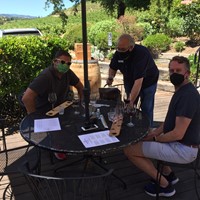
Part three, Open/Close/Open/Close/Open, or here we go again. Earlier this week the State and County allowed us to reopen outdoor tasting. It reminds me of movie sequels: the third iteration is almost always filled with over the top shenanigans or huge groans--Little Fockers, Highlander III or Daddy Day Camp anyone? I can guarantee we won’t be having any of those shenanigans and will keep the groans to a minimum. We’ll offer great wine selections served on our deck surrounded by Mother Clone Zinfandel vineyard vistas.
Along with the re-opening of our Tasting Room there is more good news this week here in Sonoma County. Rain and lots of it thanks to an atmospheric river which is drenching the entire state and states around us. They are counting several feet of snow in the mountains and flash flood warnings are being sent to us in the lowlands. The irony of the reopening to only outside tasting now? It happened right in the middle of our first major rainstorm. We’ll take it! And the hills are wearing their winter green giving visitors gorgeous views.
We take on challenges like this all the time. As I have said before we are all in this together and I know how this has turned our lives upside down. The good news is we have come out of the latest stretch of sheltering in place and businesses are being able to function again. The opening of operations is slow-pretty sure slow and steady will win the virus race. We'll look to future months (summer? fall?) as we hope for indoor tasting to open up. Large gatherings are still a big no but even the Wine Road, our trade group, is planning some of their signature events for later in the year, pandemic proofed of course.
I for one am looking forward to dining outside at our great local restaurants. I am aware that other states, with lighter guidelines, have already been doing this but here in California we are in for a treat after waiting and wondering when we can go out again-and so many of our local restaurants have invested in outdoor seating. You can bet many of us will be making our reservations and bundling up if it's cold. Like our winemaker Montse Reece said the other day “I can’t wait to go out to eat and have the food fixed and served at the restaurant itself-no more take out!”
Categories
- COVID
- Follow the Vineyard
- Note from Home
- PairItWithPed
- Pandemic
- pedroncelli
- Port
- Postcards from Home
- Pruning
- Seasons in The Cellar
- Tasting Room
- Thanksgiving
- Vintage Notes
- Winemaking
- Women's History Month
Recent posts
-
91 Years Later
-
Come Over October: It's About Community
-
Come Over October
-
A Legacy Continues!
-
Everything Old is New Again
Popular tags
- food and wine
- Anniversary
- 1974 Cabernet Sauvignon
- Sauvignon Blanc
- Four Grapes Port
- Harvest 2022
- Homecooking
- OpenThatBottleNight
- Lake Sonoma
- Block 007 Cabernet Sauvignon
- newsletter
- Pantry
- Barrels
- Dry Creek Valley
- Easter
- Finding Your Roots
- COVID Coffee Chat
- cooking with wine
- Cookies
- Schotzki
- Pruning
- Merlot
- Pedroncelli
- family
- Mother Clone
- cheese
- Follow the Vineyard
- Holding steady
- Habit
- American Oak
- PairitwithPed
- Estate Vineyard
- Reserve
- Rosé
- Down to Earth
- Bushnell Vineyard
- Library Wine
- Heat wave
- Sonoma County
- Courage Zinfandel
- Recipes
- note from home
- Cellar Master
- Seasons in The Cellar
- Cabernet Sauvignon
- French Oak
- Pandemic
- Crop set
- COVID19
- Oak





